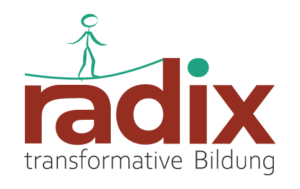Brief description
In this method, participants can raise, question and unlearn their associations with unrealistic and unhelpful ideals of and demands to activists in their specific fields of activity in a humorous way.
Learning objectives
The participants…
- recognize their high expectations towards themselves and others in their field of activity.
- recognize the inconsistency and unattainability of requirements that often remain unspoken at a collective level.
- question assumptions about hidden hierarchies regarding knowledge, skills, invulnerability, etc.
Procedure
Background
Perfect Activist comes from the topics of sustainable activism and individual/collective resilience (ability to resist and recover in crises). Activists are constantly in contact with the multiple crises of this world and often have high expectations towards themselves and others.
Preparation
A flipchart with a stick figure on it is placed in the middle of the participants. It has proven useful for one facilitator to moderate while the other facilitator writes down the associations made by the participants.
Implementation
1. (3 minutes) Introduction
The facilitator formulates introductory words, e.g:
We are now going to do an exercise to look together at the expectations we have towards ourselves and others in context xy. You probably know the feeling that there are activists in your environment who simply do everything right, or at least „better than me“. We want to playfully reveal and express this here.
2. (2 minutes) Contemplation
The participants sit in a circle and the flipchart with the drawn stick figure is in the middle. The facilitator asks introductory questions and invites the participants to spend two minutes on their own.
Example questions: „What can the perfect activist do? What do they do? Where does the person come from, what do they need? What do they live from and for? What is the person like? What is the person’s everyday life like?“
These questions can be adapted and expanded depending on the area of activity/commitment.
3. (10 minutes) Association exercise
The participants can freely associate and throw their thoughts on ‚the perfect activist
into the round. The facilitator writes the terms around the stick figure on the flipchart. Conflicting associations are also written down. Depending on the development of the associations, the instructors can also consciously point out contradictions between the individual associations, or invite further associations, ask questions about areas that have not yet been mentioned, etc.
4. (10 minutes) Evaluation The group is in plenary. The following questions can be asked:
- Invite feelings: What did these claims trigger in you?
- Where do you notice contradictions?
- Is it even possible to fulfill them?
- Can we recognize systems/thought patterns in these demands that we actually want to criticize, change or abolish? (e.g. capitalist ideas of exploitation)
-
Stripping off the claims: Inviting people to shake out or strip off their bodies.
Variants
After collecting the terms together on the flipchart, the participants go into individual work in which they either write freely for 10 minutes or draw. The following questions are given to the participants:
- Where do I recognize these demands in myself?
- Which of these demands do I experience as stress?
- What do I want from people around me in stressful situations/phases?
After 10 minutes of individual work, the participants go into a 10-15 minute small group discussion about their experiences. These are no longer shared in plenary.
Digital implementation
An online tool is needed in which a stick figure or a person’s head is drawn on a presentation slide. The associated terms of the participants are written into the chat and read out loud by a facilitator.
Tips and notes for instructors
The method enables reflection on how unattainable, stress-inducing and often contradictory these demands can be. It gives the participants access to the topic of resilience and invites them to speak. In addition, it triggers an „unlearning“ of one’s own demands, both individually and at group or collective level.
The method can be used in various fields of activity, e.g. voluntary services, educational work, role issues in groups, etc.
Give the participants time to feel their way into the respective demands. Depending on the context, further questions about the perfect activist can be asked in the room. E.g.: „What kind of clothes does the person wear? How do they eat? Where does their knowledge come from? How does the person behave towards others?“ The questions and answers can be exaggerated. It is important to demystify the claims that arise afterwards and to realize in a reality check that they are not our common goal at all, that they are unfulfillable anyway and probably contradictory in themselves.
Stripping away is important for physically letting go of demands.
It can often take a while for participants to realize that it’s about questioning these demands. If this leads to a noticeable moment of relief in the group, for example, it can be useful to name and address this in the reflection.
Possibilities for further work
Topics: individual and collective self-care and resilience, stress and burnout.
Funded by the European Union. Views and opinions expressed are however those of the author(s) only and do not necessarily reflect those of the European Union or the European Education and Culture Executive Agency (EACEA). Neither the European Union nor EACEA can be held responsible for them.


